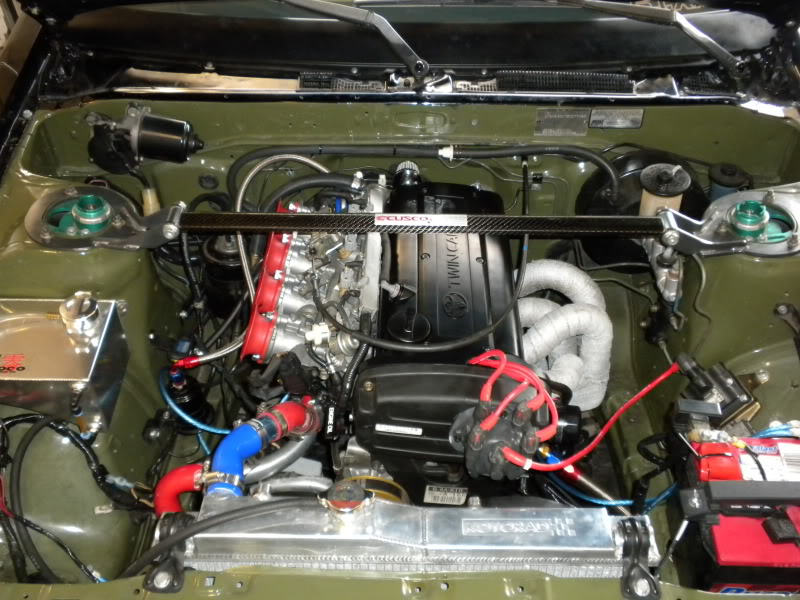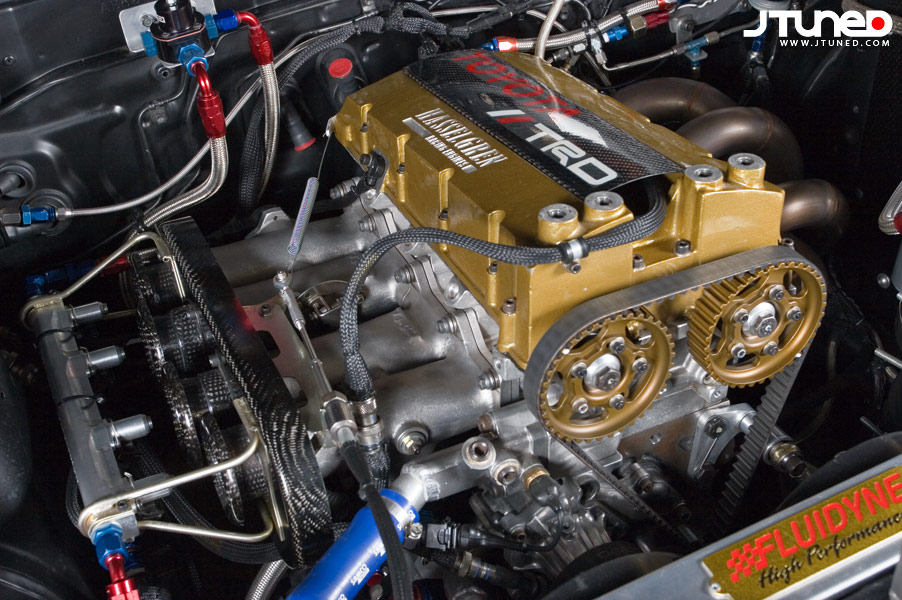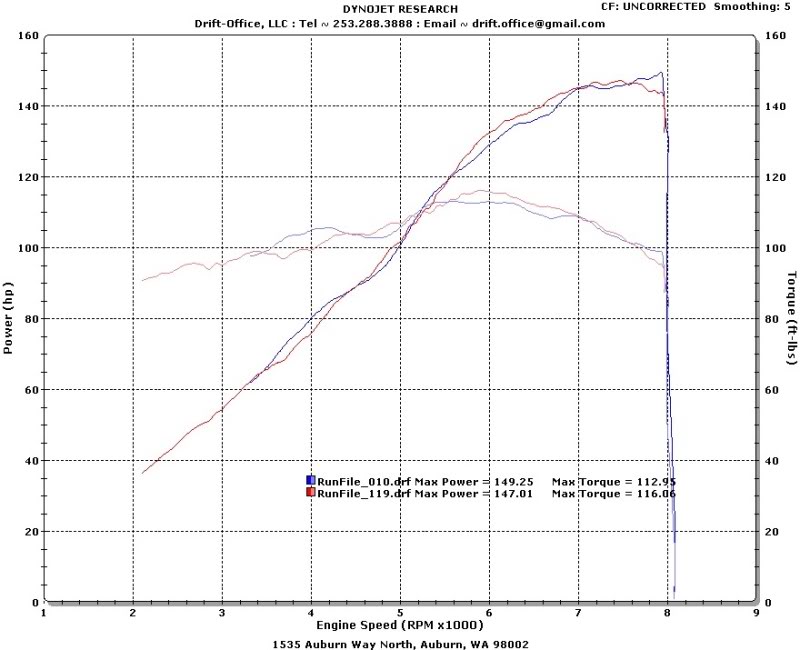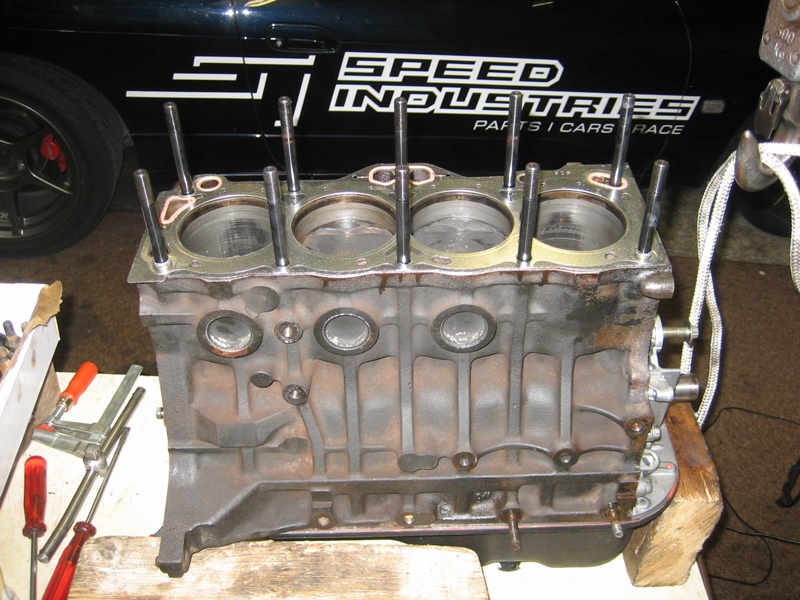The hachiroku is a great car to learn to drive fast. Fast in the sense of being fast and not just being able to burn a good time on the quatermile or getting impressiv 0 – 100km/h results. Nevertheless, if you like racing, drifting, autoX at one point, you will desperately start to search for a few more horses. The answer is just a short read away!
All over the world you find a lot of information on tuning the 16V engine as well as useful guides about the 20V swap. Honestly, there is still one big question. Which way should I choose? This is a question to answer for yourself, this post shall only be a objective guide what can be done with what amount of money! To answer the money question straight ahead, a good naturally aspirated engine build/tune will cost you around 100 CHF/USD per horsepower. The ballpark to consider, as we set our target to 165BHP, is approximately 4000 quid. Enought said, now it’s time for reality.
A clean 20V installation costs money
Starting with the 20V, the result might be convincing, but it’s a long way to go and invovles several skills in fabrication, electronics and planning. The block is nearly the same as the the original AE86 4age, so it bolts in directly in the original place. The engine originally was designed for FWD. So the coolant routing, the ignition system and the air intake was never designed to fit or even work in a RWD chassis. You need to consider this for your build.
This is the list with points you have to address if you decide for the 20V route:
- Engine: AE111 4age 20V Blacktop – 165BHP
- Waterrouting kit: SSWorks
- Distributor relocation kit: SPTec
- Airbox, funnels, etc.
The engine will be around 2000.- CHF delivered to switzerland and bought from Speed Industries, but it’s a factory reliable unit, never opend, runs and runs and runs…
Found on Jtuned – A real 16V monster 🙂
On the other hand, you have your factory 16V engine, which is pretty much stock, worn out and has half a million km on the clock. This engine could be a good start to build the ultimate 140whp weapon. Braking the big project down to small projects we have to realize, to hit this magic number, we cannot build an engine in steps. Compression, Camshafts, Carburation / ECU need to work altogether, but we have a freshly built engine being able to take some serious abuse. At this point consider a good engine builder as your partner for the project. He can help you build a good bottom end and avoid any problems during the next 100’000km.
The parts you should consider for such build are:
Block:
- Pistons to get aprox 10.5 – 10.8:1
- Fresh bearings
- ARP all the way
- Balance, balance and balance!
Head
- Ported polished (esp. exhaust port)
- Fresh valve job, 3 Angle
- Cams 272/264, 272/272 or 288/272
Depending rev range, target, purpose - Springs / (ev. underbucket conversion)
Misc
- Header
- ITB, Airbox
- ECU
- Flywheel / ClutchKit
No matter how hard you try, you can’t cheat physics, compression ratio, carburation / ecu, cams will go hand in hand. If you chose them right you get the target. The 140whp can’t be achieved without changing the ECU. It has all been done before.
Conclusion:
It’s your personal decision, which way you go. A solid 20V swap will be expensive, the 16V build will be expensive, as well. As you invest cash into a head, you can also consider a smallport 16V head, which will give you a bit more torque and in the midrange and is prooven to be the better choice up to 180 – 200bhp, which is still a big bump from 165bhp.
Found on Hachiroku.net – Comparison: Smallport 16V built vs. stock 20V, header, exhaust
Alternative:
You are the racer, but have a bit of a tight budget, maybe the small step between an OEM 16V and a proper built one is the way to go. You don’t need the ECU which will safe you about 500 – 1’500 USD depending on manufacturer and you can safe cash as you push the limits of the OEM parts.
- OEM Bluetop rebuild
- 10.0:1 OEM EU Pistons
- Headache (the usual porting, shaving)
- HKS 264/256
- Flywheel
- FPR
A blown engine, can be an oportunity, step forward and do it right!
The car will put somehting around 120whp (145bhp) down which will be an impressive 25 – 30whp more than stock. I did this step, as I had to rebuild my engine with a reasonable amount of time as I blew my engine in the car. The result wasn’t a sub 10s quatermile hachiroku, but on the winding roads in black forest the car was incredibly responsive and I felt much more confident with the new engine. Step on it and see the needle climb to 7000!The hachiroku is a great car to learn to drive fast. Fast in the sense of being fast and not just being able to burn a good time on the quatermile or getting impressiv 0 – 100km/h results. Nevertheless, if you like racing, drifting, autoX at one point, you will desperately start to search for a few more horses. The answer is just a short read away!
All over the world you find a lot of information on tuning the 16V engine as well as useful guides about the 20V swap. Honestly, there is still one big question. Which way should I choose? This is a question to answer for yourself, this post shall only be a objective guide what can be done with what amount of money! To answer the money question straight ahead, a good naturally aspirated engine build/tune will cost you around 100 CHF/USD per horsepower. The ballpark to consider, as we set our target to 165BHP, is approximately 4000 quid. Enought said, now it’s time for reality.
A clean 20V installation costs money
Starting with the 20V, the result might be convincing, but it’s a long way to go and invovles several skills in fabrication, electronics and planning. The block is nearly the same as the the original AE86 4age, so it bolts in directly in the original place. The engine originally was designed for FWD. So the coolant routing, the ignition system and the air intake was never designed to fit or even work in a RWD chassis. You need to consider this for your build.
This is the list with points you have to address if you decide for the 20V route:
- Engine: AE111 4age 20V Blacktop – 165BHP
- Waterrouting kit: SSWorks
- Distributor relocation kit: SPTec
- Airbox, funnels, etc.
The engine will be around 2000.- CHF delivered to switzerland and bought from Speed Industries, but it’s a factory reliable unit, never opend, runs and runs and runs…
Found on Jtuned – A real 16V monster 🙂
On the other hand, you have your factory 16V engine, which is pretty much stock, worn out and has half a million km on the clock. This engine could be a good start to build the ultimate 140whp weapon. Braking the big project down to small projects we have to realize, to hit this magic number, we cannot build an engine in steps. Compression, Camshafts, Carburation / ECU need to work altogether, but we have a freshly built engine being able to take some serious abuse. At this point consider a good engine builder as your partner for the project. He can help you build a good bottom end and avoid any problems during the next 100’000km.
The parts you should consider for such build are:
Block:
- Pistons to get aprox 10.5 – 10.8:1
- Fresh bearings
- ARP all the way
- Balance, balance and balance!
Head
- Ported polished (esp. exhaust port)
- Fresh valve job, 3 Angle
- Cams 272/264, 272/272 or 288/272
Depending rev range, target, purpose - Springs / (ev. underbucket conversion)
Misc
- Header
- ITB, Airbox
- ECU
- Flywheel / ClutchKit
No matter how hard you try, you can’t cheat physics, compression ratio, carburation / ecu, cams will go hand in hand. If you chose them right you get the target. The 140whp can’t be achieved without changing the ECU. It has all been done before.
Conclusion:
It’s your personal decision, which way you go. A solid 20V swap will be expensive, the 16V build will be expensive, as well. As you invest cash into a head, you can also consider a smallport 16V head, which will give you a bit more torque and in the midrange and is prooven to be the better choice up to 180 – 200bhp, which is still a big bump from 165bhp.
Found on Hachiroku.net – Comparison: Smallport 16V built vs. stock 20V, header, exhaust
Alternative:
You are the racer, but have a bit of a tight budget, maybe the small step between an OEM 16V and a proper built one is the way to go. You don’t need the ECU which will safe you about 500 – 1’500 USD depending on manufacturer and you can safe cash as you push the limits of the OEM parts.
- OEM Bluetop rebuild
- 10.0:1 OEM EU Pistons
- Headache (the usual porting, shaving)
- HKS 264/256
- Flywheel
- FPR
A blown engine, can be an oportunity, step forward and do it right!
The car will put somehting around 120whp (145bhp) down which will be an impressive 25 – 30whp more than stock. I did this step, as I had to rebuild my engine with a reasonable amount of time as I blew my engine in the car. The result wasn’t a sub 10s quatermile hachiroku, but on the winding roads in black forest the car was incredibly responsive and I felt much more confident with the new engine. Step on it and see the needle climb to 7000!




